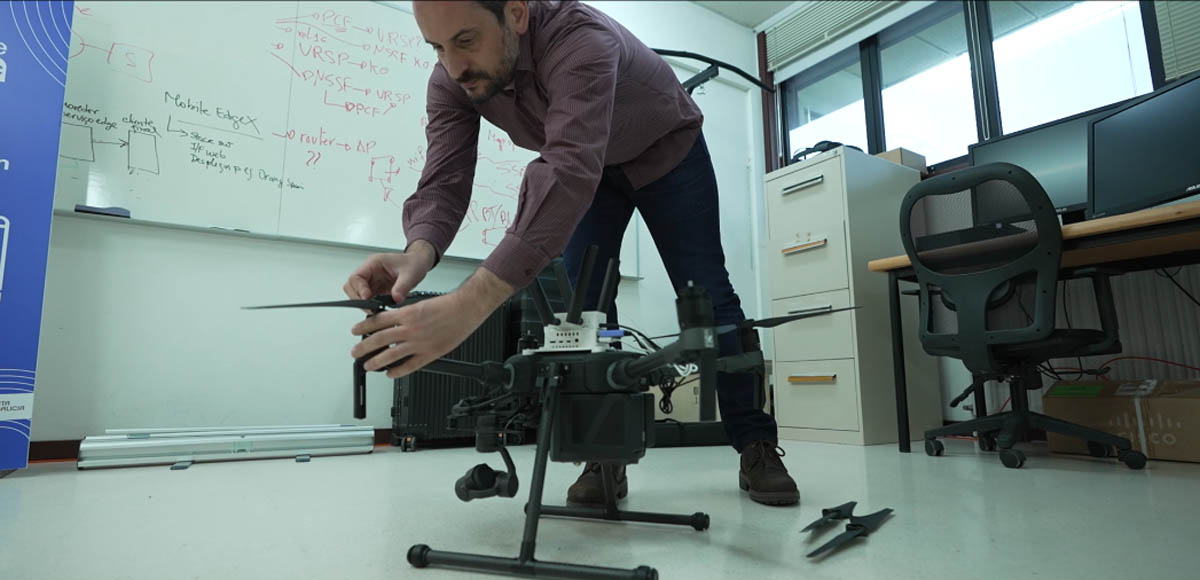We have a series of unique infrastructures for the proper development of our research staff’s activities, which are also enhanced by providing services to the scientific and business community in general, nurturing the promotion and fostering of relationships with other institutions, public bodies, research centers, and companies.
High-Frequency Laboratory
A laboratory dedicated to the design, simulation, and characterization of high-frequency circuits and devices, standing out among its equipment: a vectorially calibrated large-signal measurement system, based on the Keysight Technologies Nonlinear Vector Network Analyzer (NVNA) PNA-X, with a bandwidth from 20 MHz to 50 GHz for powers below 1 W, up to 20 GHz for 20 W; wafer probe station, Cascade, with temperature control ranging from 10-200 ºC; ThorLabs anti-vibration table; Keysight Technologies CXA signal analyzer, up to 26 GHz; HP8510C Vector Network Analyzer (VNA) from 45 MHz to 50 GHz; baseband non-linear network analyzer, 10 kHz-45 MHz, NMDG; 5 vector signal and analog signal generators in different frequency bands.
Land-Based Test Site (LBTS)
A laboratory located in the Technology Logistics Park (PTL), which houses a demonstrator of the Integrated Services System (SSI), a project developed for Navantia in the field of 4.0 ships and digital twins.
In this laboratory, other demonstrators were also developed: the DIAR (High-Resolution Instrumental Demonstrator) and the DIFI (Infrared Signature Instrumental Demonstrator), systems for measuring the radar and infrared (IR) signature of naval, terrestrial, or aerial units, and a third system, the DIGE (Electronic Warfare Instrumental Demonstrator), a system for training and diagnosing electronic warfare equipment.
Radioelectric Measurement Laboratory (LMR)
The LMR has an anechoic chamber for electromagnetic measurements measuring 9m x 7m x 7m (L x W x H), and the necessary technical equipment to provide testing and measurement services for antennas, electromagnetic compatibility, radar cross-section, and various types of electromagnetic signal measurements to both the university community and research centers, technology centers, and companies.
The chamber is designed to operate up to 40 GHz and is equipped with, among other things, high-performance automated positioning systems, high-end equipment, far-field transformation software, and a spherical range measurement system.
QOPHI Laboratory (Quantum, Communication, Photonics & Integration)
The technical equipment available in the QOPHI laboratory enables the provision of specialized R&D services, design, as well as expert technical guidance and consultancy in photonics and integrated photonics: design and simulation of photonic integrated circuits (PICs) in InP, SiN, and Si, optical and electrical characterization of PICs at the wafer and cell level, circuit characterization on an optical table in free space and with optical fiber.
Among its equipment, in addition to the setup for the characterization of photonic chips, it includes a powerful high-performance server (HPC) for analyzing the security of quantum cryptography systems with photonic technology to enhance activities in the design of integrated photonic devices and secure quantum communications
Ground Station
There are two ground stations for satellite tracking and operation. Both stations are equipped with antennas and equipment for VHF, UHF, L-band, and S-band.
The stations are also used to provide support for missions of other entities during the LEOP and commissioning phases, as well as in contingency situations. All of their operations are automated, thus requiring minimal operator intervention during communication periods with the satellites.
5G & 6G Communication Networks Laboratory
This laboratory, put into service in 2020, is equipped with unique infrastructure for the generation and measurement of test signals, as well as Software-Defined Radio (SDR) devices for generating signals compatible with commercial terminals. Its equipment includes: 6 servers, protocol analyzer, signal generator, 5G access SDR system, vector analyzer, spectrum analyzer, and signal analyzer.The laboratory is dedicated to research in 5G and beyond technologies to enhance the capacity to work on network function virtualization, service coexistence, programmability of communication devices, and characterization of the environment in new frequency bands.
Clean Room (ISO 7)
A Class 10,000 clean room equivalent to ISO 7, with an area of 9m² of clean zone and another 9m² of pre-chamber. It is equipped with the necessary facilities for ESD protection (grounding, dissipative flooring, ESD mats,…), protected electrical installation, UPS (Uninterruptable Power Supply), network outlets, and WiFi. This clean room is typically used for AIV (Assembly, Integration, and Verification) activities for small satellites, including subsystem and system-level tests and satellite integration.
Smart Room
This infrastructure facilitates the exploration of computer system´s ability to interpret human communication and behavior. Crafted as an intelligent room equipped with sensors, cameras, and microphones, it enables the automatic analysis of activities within the room. This analysis allows the system to enable decision-making, and provides diverse viewpoints on users’ actions. That offers valuable insights to users regarding their activities.
Semi-Anechoic Acoustic Chamber
This space provides the necessary reference acoustic conditions for characterizing sound sources without the influence of reflections and reverberations. In this room, tests related to acoustic power (according to UNE EN ISO 3744, 3745, and 3746 standards), verification of sound sources in compliance with the requirements of UNE EN ISO 140-5, and characterization of various materials can be conducted, among other activities.
The infrastructure is complemented by a Non-Environment control room, which serves as a controlled listening space, providing a uniform frequency response from 20 Hz to 20000 Hz.
The room is connected to the semi-anechoic chamber: the test and recording equipment is installed in the control room, allowing for monitoring and recording of both video and audio during tests conducted in the semi-anechoic chamber. The room’s configuration and acoustic conditions enable the evaluation of the acoustic quality of sound sources and audio encoding systems.
Thermal Vacuum Chamber
An infrastructure that allows for thermal vacuum testing of small satellites, proving to be highly valuable for both aerospace technology research and its enhancement through the provision of specialized services to the industrial sector. Some of its specifications include a cylindrical chamber of 450mm x 500 mm, pressure of 10-2 mbar, temperatures ranging from -150°C to +150°C, and a heating and cooling rate of ±2ºC/min.



















































